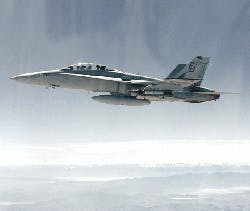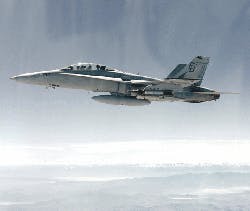PowerPC and Fibre Channel to power new F/A-18E/F avionics
PowerPC and Fibre Channel to power new F/A-18E/F avionics
By John McHale
KANATA, Ontario — A major avionics upgrade to the U.S. Navy/Marine Corps Boeing F-18E/F Hornet jet fighter-bomber will rely on the PowerPC microprocessor and the Fibre Channel high-speed serial data bus.
Engineers from the avionics manufacturer, General Dynamics Information Systems in Minneapolis, chose a new PowerPC-based 6U VME single-board computer from DY 4 Systems Inc. of Kanata, Ontario. The DY 4 DMV-179 board uses a new bridge chip from Galileo Technology in San Jose, Calif. General Dynamics also will use the DY 4 PMC-642 Fibre Channel network interface PCI mezzanine card for the Hornet`s new Advanced Mission Computer and Display system.
The Galileo Technology GT-64130 bridge chip provides as much as 48 megabytes of 64-bit memory-mapped FLASH memory and as much as 256 megabytes synchronous DRAM with error-checking and correcting without using a mezzanine. It also features a 64-bit PCI local bus with a 264-megabytes- per-second peak transfer rate to support high bandwidth I/O devices such as Fibre Channel or graphics PMCs.
Galileo`s chip is suited to the military market because it has a large capacity to support Flash memory and it also has DMA controllers, additional timers, and a 64-bit PCI, says Stewart Dewar, product marketing manager for DY 4.
The new DY 4 single-board computer also has the ability to use Motorola`s upcoming AltiVec PowerPC microprocessor as it operates at speeds as fast as 400 MHz.
The GT-64130 is a single-chip PCI system controller for 64-bit PowerPC microprocessors and the Motorola MPC860. The device contains key system peripherals such as a SDRAM controller, device controller, direct-memory-access engines, timers, and fast PCI interfaces.
The GT-64130 includes a dual-mode PCI interface unit that can support two independent 32-bit PCI buses or one 64-bit PCI interface. The chip also supports bus speeds as fast as 66 MHz, as well as an industry-standard I2O messaging unit. Universal PCI for both 3.3-volt and 5-volt signaling is included.
The 64-bit device controller on the GT-64130 supports memory devices such as SDRAM, Flash, and SRAM. The device also has a 75 MHz interface to SDRAM.
Each of the F-18E/F Advanced Mission Computer and Display systems will use four PowerPC-based DMV-179 boards. Connecting the processors to the rest of the avionics system will be the PMC-642, which is part of DY 4`s recently introduced Channel 1 system area network architecture.
The computer upgrade will replace the existing F/A-18E/F mission processor, the old AN/AYK-14, which is the U.S. Navy`s standard mission computer found on other aircraft such as the Air Force Boeing F-15 fighter, Marine Corps Boeing AV-8B jump jet, and the Navy Northrop Grumman EA-6B electronic warfare aircraft.
"There are currently over 2,000 aircraft that could potentially be retrofitted with this technology," says Danny Osadca, president and chief executive officer at DY 4.
The DMV-179 has dual 64-bit, 33 MHz PMC sites for high-performance I/O, 1 megabyte of L2 cache, 12 bits of discrete I/O each with interrupt capability, four general-purpose DMA controllers on the PCI bus, as well as SCSI Ethernet and serial I/O ports.
For ease of use, designers can access the Ethernet and serial I/O from the front panel. The new board requires typically 17 watts and features DY 4`s Column Grid Array packaging for long service life.
The new single-board computer is pin compatible with DY 4`s earlier generation of PowerPC boards. It is also available in a range of ruggedization levels, including air and conduction-cooled.
The new board comes with foundation firmware, including a debug monitor and non-volatile memory programmer, a suite of board support service routines, BIT firmware, and 95 percent BIT fault coverage. VxWorks or LynxOS real-time operating system support is also available.
The $1 million contract award is the second order DY 4 has received for the engineering manufacturing design phase of the Advanced Mission Computer and Display system avionics upgrade program. DY 4 has already begun delivering product on the initial order.
Over the next three to five years, as these programs transition to the low-rate initial-production phase, the follow-on potential for other AYK-14 avionics upgrades is upwards of $20 million, DY 4 officials claim.

